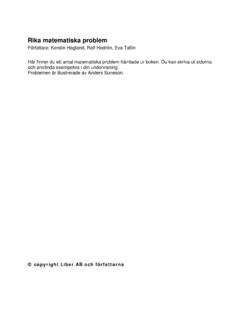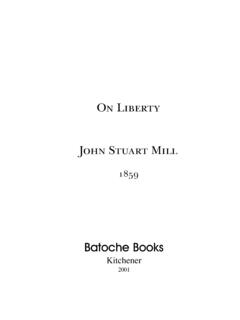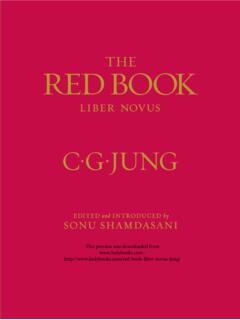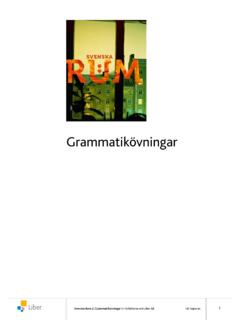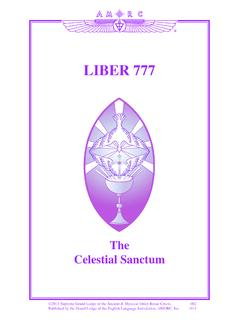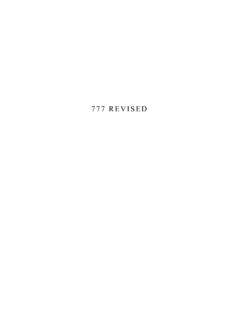Transcription of On the origin of the Fibonacci Sequence
1 On the origin of the Fibonacci Scotta, P. Marketosb,caInstitut f ur Physikalische Chemie, RWTH Aachen University, 52056 Aachen, Germany,email: School, International Baccalaureate Department, 14, N. LytraStreet, Psychiko 154 52, GREECE, email: Florinis Street, 152 35 Vrilissia GREECEA bstractHerein we investigate the historical origins of the Fibonacci numbers. Afteremphasising the importance of these numbers, we examine a standard con-jecture concerning their origin only to demonstrate that it is not supportedby historical chronology. Based on more recent findings, we propose insteadan alternative conjecture through a close examination of the historical andhistorical/mathematical circumstances surrounding Leonardo Fibonacci andrelate these circumstances to themes in medieval and ancient history.
2 Cul-tural implications and historical threads of our conjecture are also examinedin this words: Fibonacci , Medieval, Islam (Medieval), Greek, Egyptian,Amazigh (Kabyle), Bejaia01A13, 01A35, 01A20, 01A301. IntroductionConventional wisdom suggests that the Fibonacci numbers were first intro-duced in 1202 by Leonardo of Pisa, better known today as Fibonacci , in hisbookLiber abaci, the most influential text on mathematics produced in Eu-rope at that time. The Fibonacci number Sequence appeared in the solutionto the following problem: A certain man put a pair of rabbits in a place surrounded onall sides by a wall. How many pairs of rabbits can be producedfrom that pair in a year if it is supposed that every month eachPublished by MacTutor History of MathematicsMarch 23, 2014pair begets a new pair which from the second month on becomesproductive?
3 The resulting Sequence is1,1,2,3,5,8,13,21,34,55, (1)( Fibonacci omitted the first term inLiber abaci). The recurrence formula forthese numbers is:F(0) = 0F(1) = 1F(n) =F(n 1) +F(n 2)n >1.(2)Although Fibonacci only gave the Sequence , he obviously knew that thenthnumber of his Sequence was the sum of the two previous Kepler, known today for the Kepler Laws of celestial mechanics,noticed that the ratio of consecutive Fibonacci numbers, as in for example,the ratio of the last two numbers of (1), approaches which is called theGoldenor divine ratio ( see [Cook,1979]):5534= =1 + 52(3)In a detailed analysis [Jung&Pauli,1952/2012], the Nobel-prize winning Physi-cist W. Pauli discussed possible influences on Kepler concerning the formu-lation of his Kepler laws , the mathematical relations put forward by Ke-pler (1571-1630) in an effort to fit the astronomical data of Tycho Braheof Copenhagen.
4 Kepler s laws were eventually derived by Newton throughthe application of Galileo s findings in dynamics. This successful effort gavebirth to the science of Classical Mechanics , upon which Modern Physicsand all its far-reaching technological applications and philosophical conceptsare to Pauli, two of the most important pervasive influences on Ke-pler s beliefs originated from Pythagorean Mathematics and the Fibonaccinumbers as manifested in the morphology of plants [Jung&Pauli,1952/2012, ,189]. In particular, Kepler s firm belief that the number 3 (a Fibonaccinumber) was more important than the number 4 (which is not in the Fi-bonacci Sequence ) in contradistinction to what other competing astrologersbelieved. According to Dampier [Dampier,1966, ], Kepler was search-ing.
5 For the mathematical harmonies in the mind of the Creator .2 Fig. spirals in pine of Warren Wilson College PhysicsDept. [Collins,2011].It has been noticed that leaf ar-rangements on certain plants andpetals on some flowers follow pat-terns described by the Fibonacci se-quence [Cook,1979, V]. The pres-ence of Fibonacci numbers in pinecones has received particular atten-tion [Cook,1979, VII]. From a topview of a pine cone as shown in Fig-ure 1, two sets of spirals may be dis-tinguished: one in the clock-wise di-rection and another in the counter-clockwise direction. The ratio of thenumbers of each set is almost alwaysa ratio of two Fibonacci helices, based on small Fibonacci numbers, appear in the arrange-ment of leaves of many plants on the stem.
6 The Fibonacci spiral, also relatedto the Fibonacci Sequence , occurs in Nature as the shape of snail shells andsome sea shells. Cook [Cook,1979] found that the spiral or helix may lie atthe core of life s principles: that of growth. The spiral is fundamental toorganic life ranging from plants, shells to animal s horns [Cook,1979, XII]; tothe periodicity of atomic elements; to microscopic DNA (the double helix)and to galaxy formations like the Andromeda nebula [Cook,1979, XX] . Whatis unusual is that although the rabbit model problem seems contrived andartificial rabbitsdo notreproduce in male-female twins1, the Fibonaccinumbers have universal applications and appear to be ubiquitous to nature(see for example [Stewart,1995,157-166]).
7 The wealth of examples cited in the previous paragraph indicates that theFibonacci numbers represent a fundamental mathematical structure. Thepresence of these numbers and the Golden ratio in nature is certainly afascinating prevalent tendency, particularly in the botanical and zoologi-cal realms [Stevens,1979, Stewart,1999]. The presence of Fibonacci num-bers has been noted within ladder and cascade electronic network analy-1 Rabbits reproduce according to litters whose size varies according to their environ-ment. In general, they reproduce at a very high geometrical rate, that is, like rabbits (if amusingly but accurately put).3sis [Arkin,1965,3,139-142], Modern Music [Lowman,1971,9-4,423-426&436,Lowman,1971 ,9-5,527-528&536-537], tributary patterns of stream and drainagepatterns [Sharp,1972,10-6,643-655], Atomic Physics [Wlodarski,1963,1-4,61-63],Education [Curl,1968,6-4,266-274] and Economics [Falconbridge,1964,2,320-322].
8 It is not always clear why these numbers appear but in a number of in-stances, but they do reflect minimization or optimization principles of somesort, namely the notion that nature is efficient yet lazy , making the mostof available resources. The ubiquitous nature of Fibonacci numbers has eveninspired the creation of a journal, theFibonacci Golden ratio has also been used in architecture and art. It is present inmany designs, from the ancient Parthenon [Cook,1979] in Athens to Stradi-vari s violins [Arnold,1983]. It was known to artists such as Leonardo da Vinci[Cook,1979] and musicians and composers: Bach [Norden,1964,2,219-222],Bart ok [Lendvai,1971] and Debussy [Howat,1983].What has puzzled scholars over the years is the contrast between the funda-mental importance of the Fibonacci numbers themselves as opposed to theartificiality of the rabbit reproductive model by which they were apparentlyfirst introduced.
9 Fibonacci himself does not seem to have associated thatmuch importance to them; the rabbit problem seemed to be a minor exercisewithin his work. These numbers did not assume major importance and recog-nition until the 19th century thanks to the work of the French mathematicianEdouard have pondered over this and doubted or wondered about thetrue inspiration behind these numbers and Fibonacci s knowledge of his own admission, Fibonacci was influenced by Islamic scholarship (in aperiod of apex during Fibonacci s time). Historians have tried to assess thisinfluence especially since Fibonacci s contributions resemble the results ofMuslim scholars, in particular the work of Al-Khw arizm (780-850 CE) ( [Zahoor,2000, CHS,1971]), a Muslim scholar who had written a bookon the Hindu-Arabic numbers and from whose works words algebra and algorithm (a step-by-step procedure by which to formulate and accomplisha particular task) are derived.
10 This has motivated historians to associate theorigin of the Fibonacci Sequence with Muslim scholarship in the middle intent of this article is to offer a plausible conjecture as to the originof the Fibonacci numbers. We start by mentioning a relatively popular con-jecture and state the reasons, both mathematical and historical, which are4supported from recent work (notably Roshdi Rashed [Rashed,1994,2]) as towhy we believe this conjecture to be improbable. We then present our ownconjecture that fits the facts as we know them today. Finally, we examine thehistorical implications of this conjecture concerning Fibonacci s environmentafter 1200 CE, in particular, the court of Frederick II (1196-1250 CE), rulerof the Holy Roman The Standard Pascal s TriangleFirst we generate Pascal s triangle ( see [Decker&Hirshfield,1992]).
